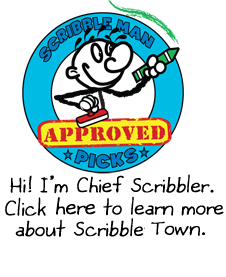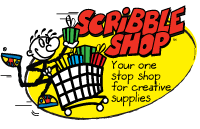Scribble Town (ST): Hi Ernest! To me, your work is very playful so I wonder how do you describe your own artwork. Especially in the portrait of you I can see the play oozing out of you as you play at work on your One Cloud painting (see below)!
Ernest Concepcion (EC): Hi! My name is Ernest Concepcion. I’m a Filipino visual artist and currently live in Brooklyn, NY. My works usually depict opposing forces engaged in ridiculous battle based on the nostalgic references of childhood and adolescence.

One Cloud, work in progress by Ernest Concepcion
ST: From the Philippines all the way to Brooklyn, where are you and what are you up to these days?
EC: I still live in Brooklyn, and have been here since moving from the Philippines in 2002. I do go back often to my home city of Manila and was just there for 6 months last year. It was probably my most productive trip so far. I was only scheduled for 1 solo show and then when my friends found out I was coming home, they invited me over to participate for more shows. In half a year, from February till August 2012, I ended up having 2 solo shows and 4 group shows, including exhibiting at a prominent museum in Manila. It was pretty crazy.

Gerana (The Wrath Of), ink, acrylic and colored pencil on paper by Ernest Concepcion
All the works were made there. For the first three months I was cranking it up doing 6 x 4 feet paintings. My sleeping habits changed. I started doing the UBERMAN cycle. Have you ever heard of that? You’re basically awake and work for 4 hours then take powernaps for 30 minutes to an hour and then work again for 4 hours and so forth. I tried it – I wasn’t exactly successful. Haha. Nah, I took it easy and still hung out with friends. I found out it’s better that way. But when I do work at the studio, I’m like an unstoppable freight train. I’m going back this year on August 2013 for more art projects.
ST: Your friends sound so great! So supportive of you and your art. I’m sure they were also just so happy to have you back home. When did you start drawing?
EC: I would say I started drawing when I was real young mostly because I was inspired by my older brother. He would draw these fantastic cars based on the 80’s movie Mad Max and I totally got into and started copying him. Later on I started drawing my own little stories with pictures on notebooks similar to the CHOOSE YOUR OWN ADVENTURES books. Comicbooks and Saturday morning cartoons have been a major influence as well. Come to think of it, my drawing style has not changed much at all. It probably has changed technique-wise in terms of perspective, anatomy, linework – but I would say it has retained its childlike qualities that harkens back to young Ernest. I was trying to think if art school changed my drawing style at all, but I think not that much. Undergrad in the Philippines was more about theory for me and my drawing process went into a dormant state because I got heavily into conceptual art and video. But when I moved to New York, it almost seems like that hibernating child-general woke up all of a sudden ready for action.

Life In A Hidden Valley by Ernest Concepcion
ST: Between all the traveling, is there a favorite place you like to create?
EC: Well, I currently work from home and do my oil paintings in my own apartment. Oftentimes I couldn’t believe how I managed to do this but I guess I was able to adapt and develop my organizational skills in paintings. So I would say this is my favorite place right now. I did have a studio in Gowanus, Brooklyn for 3 years and that used to be my favorite place to work. I would spend countless hours there and was able to produce a ton of work. But alas, I had to move out in 2009. However, when I fly back to Manila I work at Mom’s house and she has prepared a space for me to work there, which I would say is probably the best. Its right beside her garden and there’s a sense of calm and serenity in the studio – a perfect contrast to my conflict-ridden works. I’m not exactly the type who draws in the subway, in a café, etc. I don’t usually carry a sketchpad at all even. Just a notebook to jot down ideas and that’s it. I make art at the studio. When I’m at a café, I drink coffee.

Queens 2020, Ernest Concepcion
ST: What other forms of art do you practice? What are your favorite tools you use to create?
EC: I also practice installation art and I collaborate murals with my friend Mike Estabrook as the Shining Mantis. I’ve been getting more and more into comicbook making and that’s definitely something I would like to develop soon. I was a big fan of the Sharpie for my drawings, I still am! But I’m totally getting into drawing with a brush these days and India ink tends to stay longer and seem more vibrant in the long run. Also, I could make entire fields of black with an ink-filled brush and that saves a lot of time.
ST: I’m seeing and hearing a theme of childhood in your artwork, but is there something in particular you want to say with your art?
EC: In my works, I would like to express what it’s like to be a kid again. The joy of expressing relentlessly.
ST: Is there a piece of art that speaks to you?
EC: There are so much art that speaks to me, but the ones I really appreciate are the works that I could feel express a certain vibe of ferocious expression – I don’t know, I can’t explain it too well.

Pajama People vs. Apparitions, ink on acetate, watercolor on paper by Ernest Concepcion
ST: Where do you get your inspiration from and who inspires you?
EC: Right now I’m getting a lot of inspiration from independent game designers. Haha. Seriously. I’m an avid gamer and seeing the works of most indie game developers and feel the years they spent on coding, designing, beta testing and perfecting these games via patches and downloadable content never fail to inspire me. I recently attended a festival about Andy Kaufman and it ran for 2 weeks. I was there almost every day! It was amazing. For me he’s a real inspiration, and he’s true to his craft. And when I mean ‘true’, I meant he doesn’t care what he was doing really, he was totally just having so much fun at the moment. And to me that’s awesome.

Kangarok 1 and 10th, Ernest Concepcion
ST: Your work does look fun and Ernest, you have done so much! Any tips for us?
EC: I would advice to everyone to just keep making work and expressing without boundaries. I am also an art teacher myself to kids and I have always been open in encouraging my students to constantly experiment and explore. Breaking rules are great, but it will be futile if you don’t know the rules first. So learn the basics, the parameters, the limitations, the rules, and then transcend them.
ST: Thank you Ernest for sharing so much with us! And don’t forget to play Ernest’s Shooting Stars game, http://www.scribbleshop.com/content/play-shooting-stars-game-ernest-concepcion

Kangarok III
 Photo: Country Living
Photo: Country Living



 Photo:
Photo: 



 Photo:
Photo:  Photo:
Photo: 










 The Starry Night by Kristen Cumings, original by Vincent van Gogh
The Starry Night by Kristen Cumings, original by Vincent van Gogh Martin Luther King, Jr. by Peter Rocha
Martin Luther King, Jr. by Peter Rocha American Gothic by Kisten Cumings, original by Grant Wood
American Gothic by Kisten Cumings, original by Grant Wood









